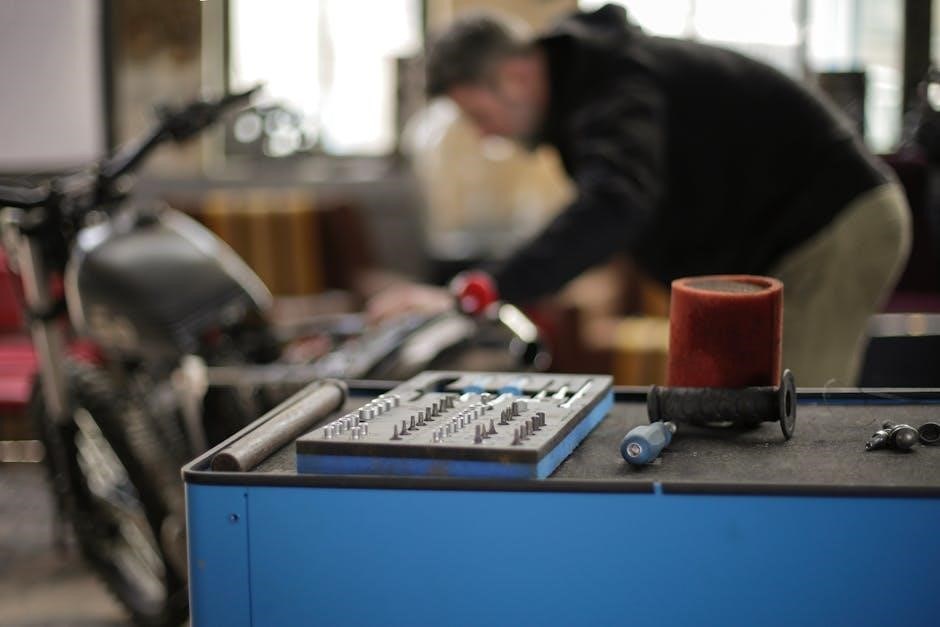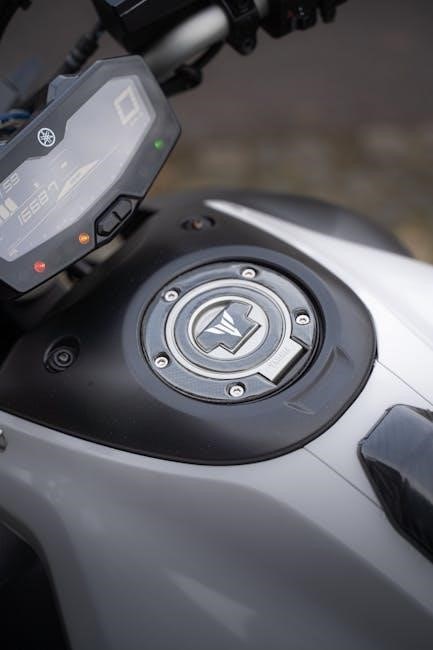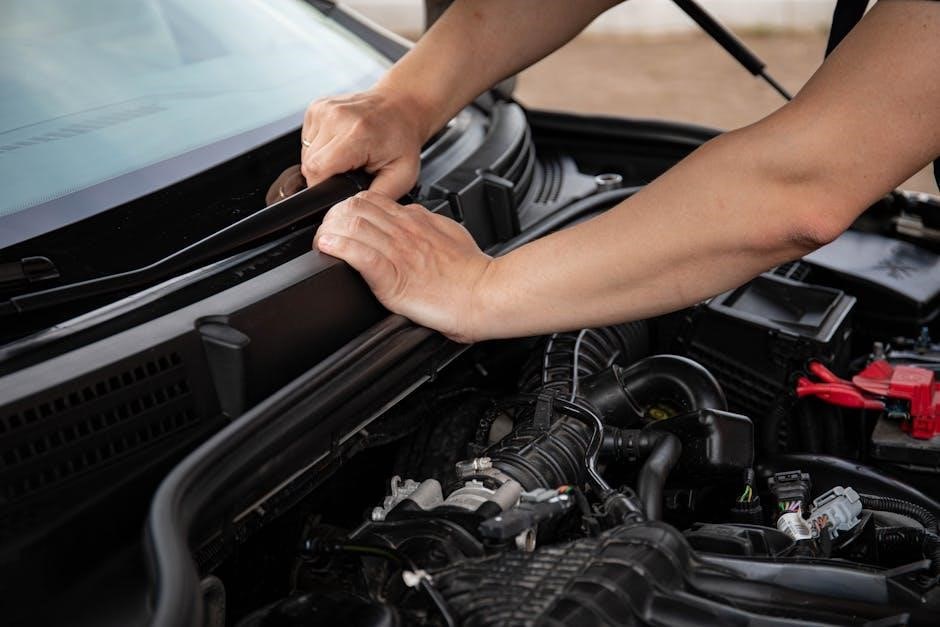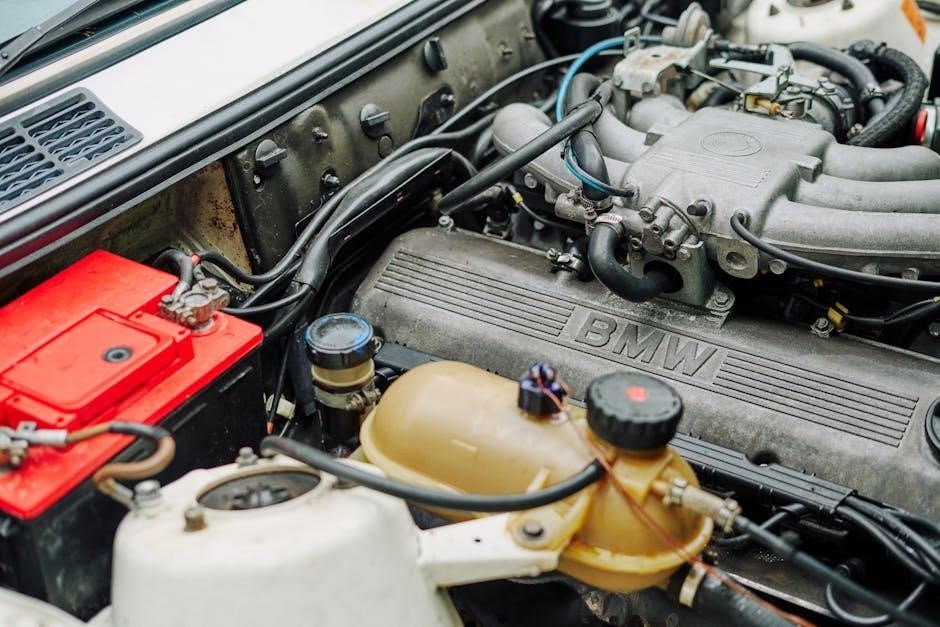Engine idle issues often arise after battery disconnections‚ as the ECU loses its idle calibration‚ leading to rough idling or stalling. A manual reset helps re-establish proper idle settings‚ ensuring smooth engine operation and preventing potential damage. This process is crucial for maintaining optimal performance and fuel efficiency‚ especially in modern vehicles with adaptive systems. Proper reset procedures can prevent prolonged issues‚ making it essential to follow manufacturer guidelines or use specialized tools for accurate calibration.
Understanding the Importance of Proper Idle Calibration
Proper idle calibration is vital for ensuring smooth engine operation‚ as it directly impacts fuel efficiency‚ performance‚ and emissions; When the idle is misconfigured‚ the engine may stall‚ hesitate‚ or run rough‚ leading to decreased drivability. Modern engines rely on the ECU to maintain precise air-fuel mixture and ignition timing at idle speeds. Improper calibration can result in increased emissions‚ poor fuel economy‚ and potential damage to engine components over time. Adaptive learning by the ECU plays a crucial role in fine-tuning idle settings‚ adapting to wear and tear on the engine. Regular maintenance and correct reset procedures are essential to prevent these issues and ensure the engine operates within manufacturer specifications for optimal performance and longevity.

ECU Adaptive Learning and Its Impact on Engine Idle
The ECU uses adaptive learning to optimize engine idle by adjusting parameters based on driving conditions. Battery disconnections erase this data‚ requiring manual resets to relearn optimal idle settings.
What is Adaptive Learning in Engine Control Units?
Adaptive learning in Engine Control Units (ECUs) refers to the system’s ability to adjust engine parameters automatically based on driving conditions. This includes idle speed‚ fuel injection timing‚ and ignition timing. The ECU continuously refines these settings to optimize performance‚ fuel efficiency‚ and emissions. Over time‚ the ECU develops a learned adaptation that ensures the engine operates smoothly under various loads and conditions. However‚ events like battery disconnections can reset these adaptations‚ requiring the ECU to relearn optimal settings through a manual reset process. This process typically involves idling the engine for a specified duration or driving under specific conditions to allow the ECU to recalibrate its parameters effectively.
How Battery Disconnection Affects ECU Memory
Disconnecting the vehicle’s battery can erase the ECU’s stored adaptive learning data‚ including idle speed and fuel trim adjustments. This occurs because the ECU relies on battery power to retain its memory. When power is lost‚ the ECU resets to factory defaults‚ requiring it to relearn optimal engine operation parameters. Symptoms of lost ECU memory may include rough idling‚ decreased fuel efficiency‚ or poor engine performance. To restore proper function‚ a manual reset or relearn procedure must be performed‚ allowing the ECU to recalibrate based on current engine conditions. This process ensures the engine returns to its previously optimized state‚ improving idle stability and overall performance.

The Engine Idle Relearn Process
The engine idle relearn process allows the ECU to recalibrate engine idle settings‚ ensuring smooth operation after battery disconnections or memory loss.
Preparation for Engine Idle Reset
Proper preparation is essential before initiating an engine idle reset. Ensure the vehicle is parked on a level surface to prevent uneven airflow and sensor misreadings. The battery must be fully charged‚ and all electrical accessories‚ such as lights and air conditioning‚ should be turned off to minimize electrical load. Allow the engine to cool down slightly‚ as extreme temperatures can affect the process. If applicable‚ ensure the coolant temperature is within the recommended range‚ typically after a short drive. Avoid using scan tools to clear codes beforehand‚ as this can disrupt the ECU’s adaptive learning process. Finally‚ inflate tires to the recommended pressure to avoid unnecessary load on the engine during the reset procedure. A stable environment ensures accurate recalibration of the idle system.
Step-by-Step Idle Relearn Driving Procedures
To perform an engine idle relearn‚ follow these driving steps carefully. Start with a fully warmed-up engine‚ as a cold engine may not adapt properly. Drive the vehicle at a moderate speed (around 40-50 mph) on a flat road‚ maintaining a steady throttle position for several minutes. Gradually vary the throttle to allow the engine to experience different load conditions. Avoid sudden accelerations or decelerations‚ as this can disrupt the learning process. Continue driving for 10-15 minutes to ensure the ECU captures a wide range of operating data. After completing the drive‚ turn off the engine and let it cool slightly before restarting to verify the idle stability. This process helps the ECU recalibrate the idle control system accurately.
Stationary Idle Relearn Techniques
Stationary idle relearn techniques allow the engine control unit (ECU) to recalibrate the idle control system without driving. Start by ensuring the vehicle is on a level surface and apply the parking brake. Shift the transmission into park (automatic) or neutral (manual) and allow the engine to idle for about 10 minutes. During this time‚ avoid pressing the accelerator or brake pedals‚ as this can interfere with the relearn process. Keep all accessories like lights‚ radio‚ and HVAC turned off to minimize electrical load. After 10 minutes‚ turn off the engine and restart it to check if the idle is smoother. This method is simpler than driving procedures and works well for vehicles with adaptive learning capabilities. Ensure the environment is safe and well-ventilated to avoid carbon monoxide buildup. This technique helps the ECU stabilize the idle control for optimal performance.

Troubleshooting When Manual Reset Fails

Check battery connections‚ inspect idle air control valve‚ ensure throttle valve is clean‚ and verify for vacuum leaks. Consult the vehicle’s service manual for guidance.
Common Symptoms of Incorrect Idle Calibration
Incorrect idle calibration can lead to rough idling‚ engine stalling‚ or hesitation during acceleration. The engine may vibrate excessively‚ and the RPMs may fluctuate unpredictably. Drivers might notice decreased fuel efficiency‚ as the engine struggles to maintain a steady idle. In some cases‚ the vehicle may stall when coming to a stop or when decelerating. Additionally‚ the “Check Engine” light may illuminate‚ indicating trouble codes related to idle control. These symptoms often occur after battery disconnections‚ ECU resets‚ or improper idle relearn procedures. Addressing these issues promptly is crucial to prevent further damage to the engine or emissions system. Proper diagnosis and recalibration are essential to restore smooth engine operation and maintain optimal performance.
Using Scan Tools for Diagnostic Trouble Codes
Scan tools are essential for diagnosing issues related to engine idle problems. When an idle calibration is incorrect‚ the vehicle’s onboard diagnostics (OBD) system often generates specific trouble codes. Codes like P0505 (Idle Control System Malfunction) or P0513 (Incorrect Idle Airflow Adjustment) may appear. Using an OBD-II scanner‚ technicians can retrieve these codes to identify the root cause of the problem. Advanced scan tools can also monitor real-time data‚ such as idle RPM‚ throttle position‚ and airflow sensor readings. This helps pinpoint whether the issue is mechanical or related to the ECU’s adaptive learning. By analyzing these codes and data‚ drivers or mechanics can determine the appropriate repair steps‚ ensuring the idle system is recalibrated correctly for smooth engine operation.
Consulting the Vehicle Service Manual
Consulting the vehicle service manual is a critical step in addressing engine idle issues. The manual provides detailed‚ model-specific instructions for diagnosing and resolving problems. It outlines the recommended procedures for resetting the idle system‚ ensuring compliance with manufacturer guidelines. The manual also includes troubleshooting charts and diagnostic flowcharts to help identify the root cause of irregular idle operation. Additionally‚ it specifies the necessary tools and precautions required for performing repairs safely and effectively. By following the manual’s instructions‚ drivers and technicians can avoid common pitfalls and ensure proper recalibration of the engine idle system. This resource is indispensable for maintaining the vehicle’s performance and longevity‚ especially after manual resets or repairs.

Preventive Measures to Avoid Future Issues
Regular maintenance‚ such as cleaning air filters and spark plugs‚ helps stabilize engine idle. Avoid unnecessary battery disconnects to prevent ECU memory loss. Always warm up the engine properly and ensure proper fuel quality to maintain optimal idle performance.
Avoiding Unnecessary Battery Disconnects
Avoiding unnecessary battery disconnects is crucial to prevent the ECU from losing its adaptive learning data‚ which can disrupt engine idle stability. Each battery disconnect forces the ECU to relearn idle parameters‚ potentially leading to rough idling or stalling. Limiting battery disconnections to only essential maintenance‚ like replacing the battery or diagnosing electrical issues‚ helps preserve the ECU’s memory. Always use a memory keeper or OBD-II battery memory saver if disconnection is unavoidable. Frequent disconnects can confuse the system‚ requiring repeated idle relearn procedures. Modern vehicles rely heavily on stored data‚ making battery stability vital for smooth engine operation. Regular battery health checks and proper charging practices further reduce the need for disconnections‚ safeguarding idle performance. Consult your vehicle’s manual for specific guidelines on battery maintenance and disconnection procedures to avoid unnecessary resets.
Regular Vehicle Maintenance Practices
Regular vehicle maintenance is essential to ensure optimal engine performance and prevent idle issues. Routine checks of air filters‚ spark plugs‚ and oxygen sensors help maintain proper air-fuel mixture and combustion efficiency. Faulty sensors or worn spark plugs can disrupt idle stability‚ leading to rough engine operation. Ensuring the throttle body and idle air control valve are clean prevents clogging‚ which can cause erratic idling. Scheduled oil changes and coolant maintenance also play a role in stabilizing engine operation. Neglecting these practices can force the ECU to constantly recalibrate‚ potentially leading to manual reset needs. Following the recommended maintenance schedule in your vehicle’s service manual helps preserve the ECU’s adaptive learning capabilities and overall engine idle performance. Consistent care reduces the likelihood of needing a manual reset and promotes smoother engine operation.

Tools and Equipment for Idle Reset
Essential tools for an engine idle reset include scan tools for ECU communication and OBD-II scanners for diagnosing trouble codes. A multimeter aids in battery voltage checks.
Scan Tools for ECU Communication


Scan tools are essential for effective engine idle reset and ECU communication. These tools allow technicians to access the Engine Control Unit to monitor and adjust parameters. Modern scan tools support real-time data streaming‚ enabling precise monitoring of idle speed and airflow sensor readings. Some advanced tools also provide reprogramming capabilities for adaptive learning reset. Popular options include OBD-II scanners and manufacturer-specific tools like J2534 pass-thru devices. These tools help identify and clear trouble codes related to idle issues. By using a scan tool‚ you can ensure the ECU is properly calibrated‚ restoring smooth engine operation. Regular use of these tools can prevent recurring idle problems and maintain optimal vehicle performance. They are indispensable for both professional mechanics and DIY enthusiasts seeking accurate diagnostics and repairs. Proper use of scan tools ensures a reliable and efficient idle reset process.
OBD-II Scanners and Their Role
OBD-II scanners are crucial for diagnosing engine idle issues by accessing the vehicle’s onboard computer. They retrieve trouble codes‚ such as P0505 for idle control system malfunctions‚ enabling precise troubleshooting. Advanced scanners offer real-time data monitoring of parameters like engine speed and coolant temperature‚ essential for assessing idle performance. Some scanners support bi-directional communication‚ allowing technicians to perform functions like idle relearn procedures. Regular use of OBD-II scanners helps in early detection of potential issues‚ preventing severe problems. They are indispensable for maintaining optimal engine operation‚ especially after repairs or battery disconnections. By leveraging these tools‚ technicians ensure accurate diagnoses and effective solutions‚ enhancing overall vehicle performance and reliability.

Real-World Applications and Manufacturer Tips
Manufacturers provide specific idle reset procedures‚ often involving OBD-II scanners or specialized tools. Following these guidelines ensures accurate calibration‚ maintaining engine performance and reliability in real-world driving conditions.
Toyota’s Idle Relearn Process
Toyota’s idle relearn process is designed to ensure proper engine idle calibration after battery disconnections or ECU resets. The procedure involves starting the engine and allowing it to run for several minutes at idle speed. Next‚ the driver must complete a series of driving cycles‚ including accelerating to a moderate speed and decelerating back to idle. This process helps the ECU relearn the optimal idle parameters. Toyota recommends avoiding sudden accelerations or stopping the engine during the relearn phase. Consistency in following these steps ensures accurate idle calibration‚ maintaining smooth engine performance and fuel efficiency. Always refer to the manufacturer’s guidelines for specific instructions tailored to your Toyota model.
Subaru’s Approach to Idle Calibration
Subaru’s idle calibration process is tailored to maintain optimal engine performance and ensure smooth operation after an ECU reset or battery disconnect. The procedure typically involves turning the ignition key to the “ON” position without starting the engine‚ then cycling the key to “OFF” and back to “ON” several times. This step helps the ECU reset its idle parameters. Once the engine is started‚ Subaru recommends allowing it to idle for a few minutes before driving normally. Avoiding sudden acceleration or stopping during this phase is crucial. Subaru’s method emphasizes consistency and patience to ensure the ECU accurately relearns idle settings. Always consult the specific Subaru model’s service manual for precise instructions‚ as slight variations may apply depending on the vehicle.
Proper engine idle reset procedures are crucial for maintaining performance and preventing issues. Regular maintenance and avoiding unnecessary battery disconnects ensure long-term reliability and optimal functionality.
Proper engine idle calibration is essential for optimal performance‚ fuel efficiency‚ and emissions control. The ECU’s adaptive learning feature adjusts idle settings based on driving conditions‚ but battery disconnections can reset this memory. A manual idle relearn process‚ including specific driving or stationary procedures‚ restores accurate calibration. Troubleshooting involves identifying symptoms like rough idling or stall issues‚ using scan tools for diagnostics‚ and consulting the vehicle’s service manual for guidance. Preventive measures‚ such as avoiding unnecessary battery disconnects and maintaining regular vehicle upkeep‚ help avoid future problems. Tools like OBD-II scanners and ECU communication devices are vital for accurate resets. Following manufacturer-specific techniques‚ such as those outlined by Toyota or Subaru‚ ensures reliability. Proper reset procedures are critical for maintaining engine health and overall vehicle functionality‚ preventing long-term damage and ensuring efficient operation.
Importance of Proper Reset Procedures
Proper reset procedures for engine idle calibration are crucial to ensure smooth operation‚ fuel efficiency‚ and emissions compliance. Improper resets can lead to issues like rough idling‚ stalling‚ or poor performance. The ECU relies on accurate data to maintain optimal idle settings‚ and skipping or incorrectly performing the reset process can disrupt this balance. Over time‚ this may result in decreased fuel efficiency‚ increased emissions‚ and potential damage to engine components. Adhering to manufacturer guidelines ensures the ECU adapts correctly to the vehicle’s specific conditions. Neglecting proper procedures can void warranties or lead to costly repairs. Consistently following reset protocols maintains engine reliability and performance‚ preventing long-term damage and ensuring the vehicle operates as intended.

Leave a Reply
You must be logged in to post a comment.